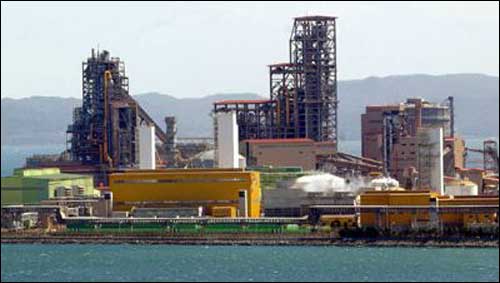Through the introduction of a real-time location system (RTLS), South Korean steel manufacturer Posco is reducing accidents, improving employee and visitor safety, and lowering energy consumption.
Posco, the world’s fourth largest steel producer, employs more than 500 workers at its Finex production plant, located in Pohang, South Korea. The presence of heavy mechanical equipment and molten steel makes the factory a hazardous working environment.
To ensure the safety of employees and visitors at the plant, Posco has introduced its “u-safety management system,” which utilizes ultra-wideband (UWB) radio frequency identification tags and interrogators to monitor all areas of the facility. Each person working in or visiting the plant is provided with a helmet fitted with a battery-powered RFID tag, allowing managers to quickly locate that individual in the event of a serious accident, such as a fire or gas leak.
Hanku Park, a senior master PCP (Posco certified professional), says his company previously had no means of tracking employees’ locations throughout the factory. “Ensuring worker safety at the plant is vital,” he says, “and we wanted a system that could track workers, visitors and even vehicles to monitor or limit their access to hazardous areas of the plant. We consulted with IBM Korea to find a solution that would best meet our needs. We conducted technical tests on the RTLS system and software that allowed us to determine the distance required between the tag and reader, given the iron and steel present as part of the production process, as well as determine tag and reader accuracy.”
Because of the large presence of metal at the plant, read distances were low, and additional readers were thus required. The tags and readers also had to be able to withstand the high temperatures found near the plant’s blast furnace. Readers were ultimately placed at the facility’s entrance gate, at staircases and on 12 manufacturing floors throughout the mill.
Bill Moton, a senior architecture manager for IBM Sensor Solutions, says the solution comprises two key components: RFID-based RTLS technology and location awareness services (LAS) middleware.
Posco uses Ubisense‘s RTLS solution, with Series 7000 RFID tags affixed to personnel and equipment. The tags operate on a frequency of 6 to 8 GHz, beaconing once per second. The Series 7000 readers receive the beacons from the tags to determine position, and that information is then transmitted to the LAS middleware over a local area network (LAN).
IBM’s WebSphere Sensor Events (WSE) software associates a tag’s unique serial number with the identity of the individual or asset to which that tag is assigned. As tag positions are updated, complex event processing takes place to determine if a safety alert should be generated. Simultaneously, a Web-browser-based client depicts the tag’s location as that tag moves around a map of the plant.
“For example,” Moton explains, “if a person moves into a restricted zone that requires a gas monitor to be worn, LAS detects the entry of the person. The resulting restricted zone entry event triggers a secondary complex event-processing action to determine if the required gas monitor, which is also RFID-tagged, is detected within close proximity of the person. This monitoring continues until the person leaves the restricted area. At any point in time, if LAS detects that the gas monitor is more than a few feet away from the person, exceeding a predetermined time interval, then LAS will generate a safety alert.”
The system can be used to respond to a number of events, including disaster response, accidental fall detection, emergency mustering, safety breach, visitor escort safety breach and worker presence or absence. The project was launched in February 2008, with technology proof-of-concept, design and development, and system testing and deployment. User acceptance testing was completed in March 2009, and the project was subsequently rolled out.
The system, Park indicates, has already shown significant benefits in improved safety and cost savings through automatic lighting control after sunset, when plant access is limited. The system detects the presence or absence of employees in various sections of the factory, using the Ubisense tags and readers, and adjusts the lighting level accordingly, in order to reduce energy consumption.
“The delivered system is working well in meeting our requirements, and improvement in worker safety is expected,” Park states. “It is too early to determine a return on investment, as it is still a pilot trial, even though real-time operations are being performed. Additionally, we expect to learn more potential functions from the system in the future.”
According to Park, with the system successfully deployed at its Pohang mill, Posco intends to expand its use to other plants as well, such as in Gwangyang, South Korea. The lighting-control function is expected to be rolled out at all Posco facilities. The company is also considering extending the system’s use to monitor work-in-process and asset management.


